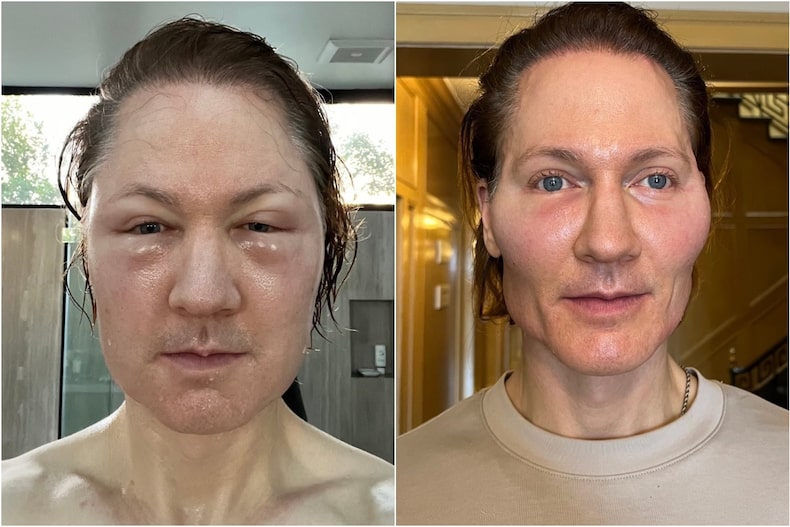Bryan Johnson, described by TIME magazine as “the man who wants to live forever,” said he suffered an allergic reaction after having donated fat injected into his face.
Brian Johnson He has been obsessed for years with finding the formula for “eternal youth”.
To slow down his aging process as much as possible and regain the physical appearance and health of an 18-year-old, the American billionaire underwent a series of medical procedures which, of course, caused great controversy.
Today, Johnson, 47, attracted attention again when he revealed he had injected fat into his face. However, they did not expect the experiment to have any adverse effects.
How did Bryan Johnson’s treatment go, which ended badly?
Johnson, who was called by the magazine TIME as “the man who wants to live forever” usually speaks in Instagram of all the interventions and routines you carry out to slow down aging.
It was on this same platform that he declared that, as part of his initiative Project plan injected fat into his face to regain the volume he had lost.
“We found that facial fat is very important in how people perceive youth. “It didn’t matter how good my biomarkers were if I didn’t have facial fat,” he explained in an article.
The billionaire clarified that although his own body fat could be used to perform the procedure, his problem was that he did not have the required amount for extraction. In this way, he ended up appealing to a donor.
After the injections, the undesirable result was immediately noticeable: he suffered from severe facial swelling, to the point of partially losing vision.
“My face started to swell, then it got worse, until I couldn’t even see. “It was a serious allergic reaction.” he described.

The businessman has not given up on his mission to stay young longer, despite the severity of the episode. And when he returned to “normal” seven days after suffering the allergic reaction, he continued to plan how to have a new face without having negative results.
“Developing a product is one thing, being the product is a completely different thing” he concluded in his publication.
What treatments did Bryan Johnson undergo?
Through its Project Blueprint initiative, which costs 2 million dollars per year Johnson has undergone several procedures to combat aging, a natural and irreversible process that occurs in all humans.
One of the experimental techniques that has aroused the most curiosity is plasma exchange with his son Talmage and his father Richard. In mid-2023, he assured that he had achieved with his loved ones “the world’s first generational plasma exchange” .
This method consisted of extracting a liter of Talmage’s blood. The blood cells were separated, resulting in plasma, which was transferred to Johnson. Then he had to do the same to give blood to his father.
The software mogul is also very careful about his daily routine. He gets up at 5 a.m., constantly takes tests to check his health, exercises for an hour, takes more pills, meditates and receives facial laser sessions.
Every day, without exception, he goes to bed at 8:30 p.m. While you sleep, you wear devices to monitor how your body is functioning.
His strict diet, as he explained, relies heavily on vegetables like broccoli, cauliflower and mushrooms. He consumes just 1,900 calories a day and doesn’t drink alcohol.

Who is Bryan Johnson?
Johnson, born in Utah in 1977, founded several companies throughout his life. The one who allowed him to build his fortune was Brain tree a payment processing company purchased in 2013 by PayPal for $800 million.
After this successful sale, Johnson went into a deep depression that led him to eat and drink excessively, as he revealed to Tutor . Nearly a decade passed like this, until he discovered biotechnology and decided to change his life.
“What I said about myself is: Do I really believe that I can live my best life on my own? And I decided that no, I couldn’t. “I just don’t have what it takes.” he explained in the interview.
In 2021, the tycoon decided to officially launch his ambitious Project Blueprint program, with which he intends to extend its lifespan and make the results known to the public. To do this, it has a team of 30 health professionals who constantly monitor it.
“We have identified practically all the scientific publications on life expectancy and health, i.e. around 2,000 publications. And we take each study, we apply a series of criteria (some are animal models, so we make that discernment) and then we set priorities,” he revealed to British media.
Source: Latercera
I am David Jack and I have been working in the news industry for over 10 years. As an experienced journalist, I specialize in covering sports news with a focus on golf. My articles have been published by some of the most respected publications in the world including The New York Times and Sports Illustrated.


